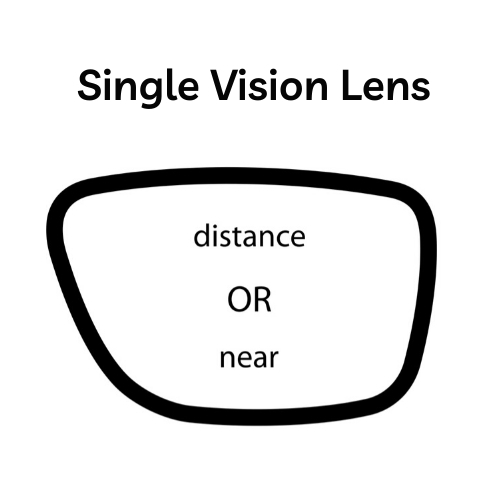Updated on May 23, 2025
Types of Glasses: Which Ones Suit You Best?


Vision Center is funded by our readers. We may earn commissions if you purchase something via one of our links.
Picking out a new pair of glasses can be overwhelming. You have an abundance of options between the different frames, lenses, and colors that many stores offer.
In this article, we’ll help you understand the different types of glasses and what suits you best.
How to Choose the Right Frames for You
One of the best ways to narrow your frame options is to determine your face shape. Here are the seven basic face shapes and what frames usually go well with them:
| Face Shape | Description | Frames |
| Round shape | Characterized by full cheeks and a rounded chin, with width and length in roughly equal proportions. Lacks strong angles. | Best with frames that have sharp angles, like rectangle or browline frames. |
| Square shape | Has a similar width and length, a wide, angular jaw, and a broad forehead. | Round, oval, rectangular, or cat-eye frames can add more balance and structure to your face. |
| Heart shape | Broader forehead, prominent cheekbones, and a narrow chin. | Best with round, geometric, or frameless glasses. |
| Oval shape | While cheekbones are prominent, typically the forehead is slightly wider than or equal to the jaw, with the cheekbones being the widest part. The defining feature is balanced proportions and a gently rounded jawline. | Frames just as wide or wider than your cheekbones will provide balance. This includes rectangular, round, and oval frames. |
| Oblong shape | An oblong face shape is longer than it is wide, similar to an oval shape. The difference is that an oblong face shape has a long, straight cheek line. | Thick, angular frames will balance the length of the face. Some examples include square, rectangular, and oversized frames. |
| Diamond shape | Diamond-shaped faces are the rarest. They have narrow, angular jaw lines, prominent cheekbones, and narrow foreheads. | Rounded frames can add softness and balance, such as cat-eye, wayfarer, and browline glasses. |
| Triangle shape | A base-down triangular face has a broad jawline, wide cheeks, and a narrow forehead. | Glasses with a wider top rim like cat-eye, wayfarer, and browline, can help to balance features. |
Where to Buy Glasses + Contacts
Best Overall: Warby Parker
Fastest Delivery: EyeBuyDirect
Also Great: Liingo
Best Place to Buy Contacts: Discount Contacts
What Are the Different Types of Frames?
Regarding material, there are two common types of frames: plastic and metal. However, other materials are also used, such as wood, mixed materials, and nylon-based materials for sports.
Plastic frames are affordable and come in a variety of colors. However, they are often less durable.
On the other hand, metal frames are durable, lightweight, and corrosion-resistant, but they can be more expensive. In some cases, metal frames can cause mild skin reactions.
Different types of frame shapes include:
- Full frame
- Semi-rimless frame
- Rimless frame
- Rectangle frame
- Square frame
- Round frame
- Oval frame
- Aviators
- Cat-eye
- Browline
- Oversized frame
- Geometric frame
What Are the Different Types of Prescription Glasses?
There are different types of prescription glasses that cater to your specific needs. Before shopping for new glasses, schedule an eye exam with your eye doctor.
They will determine what type of vision correction you need. The different types of prescription glasses include:
Single-Vision
Single-vision lenses are the cheapest and most common type of eyeglass lenses. They have the largest field of vision because they only correct vision at one specific distance (either far or near).

Your doctor will likely prescribe single-vision lenses if you have nearsightedness, farsightedness, or astigmatism.
Bifocals
Bifocal lenses are multifocal, meaning they have two different "powers" in them. These different sections of the lens correct distance vision and near vision.

Bifocal lenses are prescribed for people with multiple vision problems.
Trifocals
Trifocal lenses are similar to bifocals. But they have an additional power to correct intermediate vision. For example, the intermediate portion may be used to view a computer screen.

The main shortcoming of bifocals and trifocals is that they have a distinct line between each field of vision. This makes the sections of the lens produce a noticeable jump or abrupt change in lens power..
Progressives
Because of the drawbacks of bifocals and trifocals, progressive lenses were developed as a more advanced option. These are another type of multifocal lenses that work for anyone who needs bifocals or trifocals.

Progressive lenses provide the same correction for near, intermediate, and distance vision. They do this without the lines between each section.
Many people prefer these multifocal lenses because the transition between fields of vision is smoother.
What Are the Different Types of Non-Prescription Glasses?
Beyond vision-correcting prescription glasses, several types of non-prescription eyewear serve specific functions or address general needs.
Unlike prescription glasses, non-prescription glasses serve various functions related to a person’s lifestyle.
- Reading glasses. These are available over-the-counter or through prescription. Reading glasses are mainly used to improve your ability to see things up close. These come in strengths from +1.0 to +4.0.
- Blue light blocking glasses. These glasses are used to protect your eyes from blue light exposure due to screen time. These can also be used to help improve sleep.
- Sunglasses. These are used to protect your eyes from harsh UV lights.
- Safety glasses. These are used to protect your eyes from hazards. Many professionals use safety glasses in construction, lab work, electrical work, auto repair, and even plumbing.
What Are the Different Types of Lenses?
Besides the standard prescriptions, many lens options exist when choosing your glasses. The most common lens materials are glass, plastic, high-index plastic, polycarbonate, and Trivex lenses.
Glass lenses provide excellent visual acuity but are prone to cracking and shattering. They’re also very heavy and can cause safety issues.
Plastic lenses are lighter, cheaper, and safer to use than glass while providing similar results. On the other hand, high-index plastic lenses are even thinner and lighter than most plastic lenses.
Lastly, polycarbonate and Trivex lenses are lightweight and impact-resistant, making them standard in safety glasses, sports goggles, and children’s eyewear. However, Trivex is used more in high-risk environments than polycarbonate lenses.
Types of Lens Treatments
Lens treatments are add-ons that can be applied to your prescription lenses for different reasons. Here are the most common types of lens treatments:
- Photochromic lenses. These lenses darken when exposed to UV rays, eliminating the need for sunglasses for people who need prescription glasses. Transition or Transitions® is a popular brand name for photochromic lenses.
- Scratch-resistant coating. These are lenses with a scratch-resistant coating that increases their durability and longevity. Most modern lenses come with scratch-resistance built in.
- Anti-reflective coating (AR). AR coating, or anti-glare coating, eliminates reflections from your lenses. This increases comfort and visibility, especially when driving, reading, or using a screen at night.
- Anti-fog coating. This type of lens prevents your glasses from fogging up. This makes them a great choice for people living in colder climates. There are permanent anti-fog treatments available.
- UV-blocking lens treatment. Adding a UV-blocking dye to your lenses will reduce the number of UV rays that reach your eyes. UV light contributes to the development of cataracts.
Types of Lens Technologies
As eyeglass styles have progressed, so have the types of lens technologies. If you need lenses that provide better visual acuity, you can choose from the following:
- Aspheric lenses. Flat and thin lenses that are a good alternative to heavy glass lenses. They also reduce unwanted magnification of the wearer's eyes. They may increase visual acuity in some cases.
- High-definition lenses. HD lenses use computer-controlled surfacing technology to create free-form or wavefront lenses. This type of lens can take your visual acuity to the next level.
In this article
6 sources cited
Updated on May 23, 2025
Updated on May 23, 2025
About Our Contributors
Lauren, with a bachelor's degree in biopsychology from The College of New Jersey and public health coursework from Princeton University, is an experienced medical writer passionate about eye health. Her writing is characterized by clarity and engagement, aiming to make complex medical topics accessible to all. When not writing, Lauren dedicates her time to running a small farm with her husband and their four dogs.
Dr. Melody Huang is an optometrist and freelance health writer with a passion for educating people about eye health. With her unique blend of clinical expertise and writing skills, Dr. Huang seeks to guide individuals towards healthier and happier lives. Her interests extend to Eastern medicine and integrative healthcare approaches. Outside of work, she enjoys exploring new skincare products, experimenting with food recipes, and spending time with her adopted cats.







